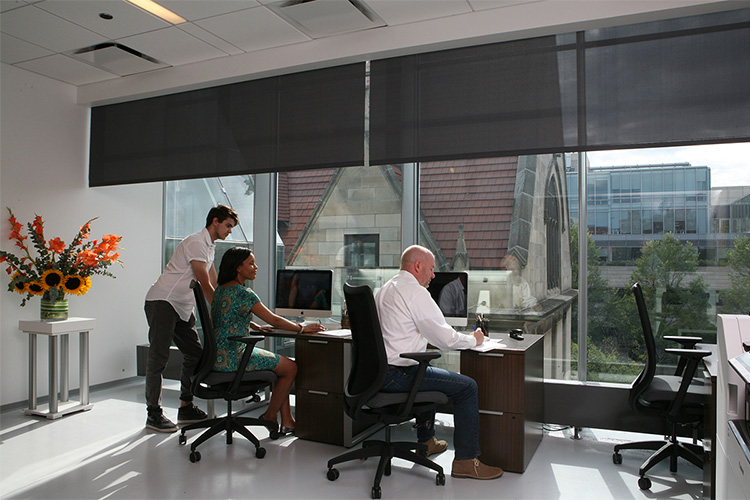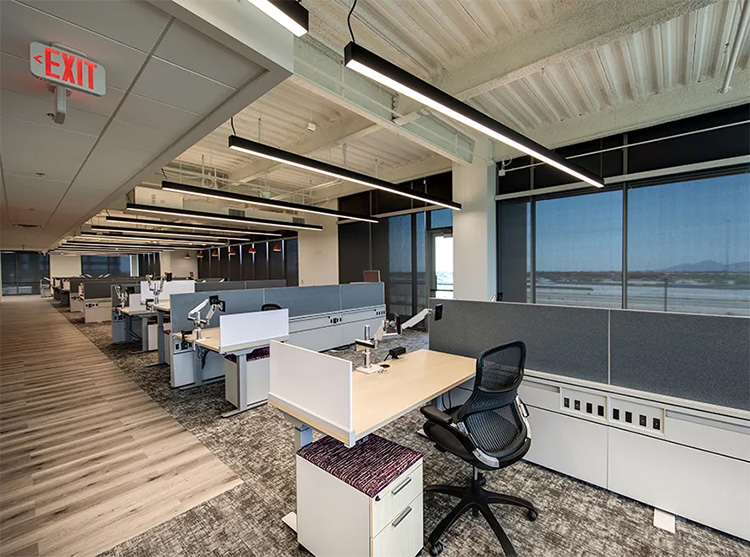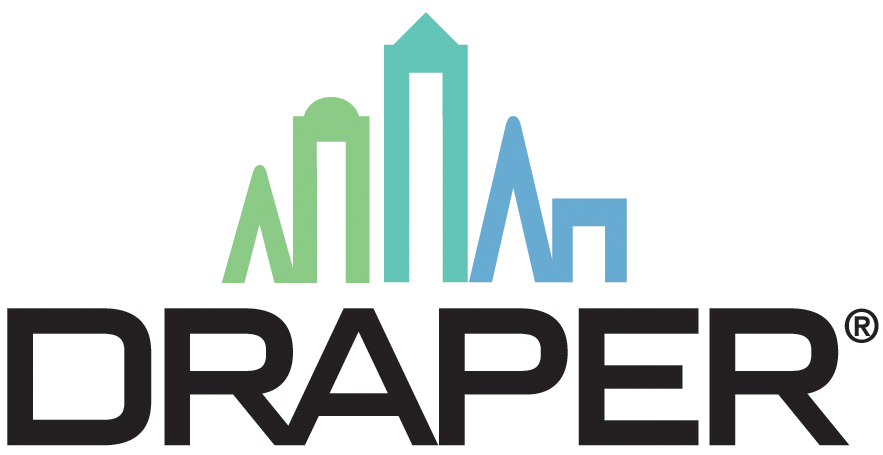Did You Know? Window Shades Can Help Increase Productivity
July 1, 2022

Motorized FlexShade® with custom redirectional channels and Mermet® E Screen fabric. University of Chicago, Gordon Parks Arts Hall. Dealer: Beverly Venetian Blind Co., Monee, Illinois. Photographer: Barry Rustin.
Read the full original article here >
The human body needs natural light to create enzymes and proteins for a healthy life. Without enough natural light, our circadian system gets out of sync and can no longer properly regulate sleep, alertness, and concentration. We become less productive. But too much direct sunlight can lead to glare and heat gain, which can make us less productive.
Did you know window shades play a key role in increasing productivity?
Does natural light really affect one’s work?

FlexShade window shades with Phifer SheerWeave 2580. Location: Cavasson offices – Scottsdale, Arizona. Integrator & Installer: Progressive Commercial Interiors, LLC. Photographer: Matt O – mattophoto.net.
As mentioned above, our bodies need natural light to regulate sleep, alertness, and concentration.
A 2019 Building and Environment article made the case how important that is to productivity. “Access to daylight and view in an office improves cognitive performance and satisfaction and reduces eyestrain: A controlled crossover study,” by Anja Jamrozik, et. al., says this:
- Employees in spaces designed to prioritize daylighting miss less work, are more productive, and make fewer mistakes [1]
- In a 1998 study of 100 diverse employees in a southern European company, workers in spaces with more daylight penetration were more satisfied with their jobs, reported better well-being, and indicated they were less likely to quit their jobs [2]
- Call center customer service representatives with better views had faster call processing times [3]
- Office workers with windows worked more than those without windows [4]
So natural light—and the means of getting it into a building—should be an essential part of designing a building for maximum productivity.
Why can’t we just use electric lighting?
Having an effective electric lighting system does not replace our need for natural light. A 1994 study [5] showed there was a statistically significant improvement in job performance in offices with windows.
And there’s more to it than just the light itself. Access to views to the outside provides a connection to nature which has also been found to have an impact on mood, satisfaction, and performance. A 2003 study [3] showed the mood of daytime workers was significantly better than nighttime workers in the same office with windows.
What happens when we add all those windows?
 With the incorporation of more windows into building design there can be some negatives. Glare, solar heat gain, and direct sun on workers’ eyes or workspaces can make it harder to perform basic work functions and lower productivity.
With the incorporation of more windows into building design there can be some negatives. Glare, solar heat gain, and direct sun on workers’ eyes or workspaces can make it harder to perform basic work functions and lower productivity.
A 2004 study by Helsinki University of Technology/Berkley National Laboratory [6] found an average decrease in productivity 2% per degree of Celsius when temperature is above 25 degrees C (77 Fahrenheit). Another study by University of Chicago researchers [7] showed as much as a 4% decrease in productivity per degree Celsius over 27 C (80 F).
A 2003 California energy Commission study [3] showed the greater the glare from primary view windows, the worse the office worker performance was, decreasing productivity by 15 to 21%.
How much is this really costing?
 Let’s imagine a typical office building with 24,300 rentable square feet, which translates into about 20,000 usable square feet. At an average of 175 square feet per employee that’s going to yield approximately 114 employees on that floor.
Let’s imagine a typical office building with 24,300 rentable square feet, which translates into about 20,000 usable square feet. At an average of 175 square feet per employee that’s going to yield approximately 114 employees on that floor.
With an average salary of $40,000 per employee, plus payroll taxes, benefits, training, and other related costs, we reach a total labor cost of $6,384,000 a year. That means every 1% gain in productivity is going to result in a savings of $63,840 annually.
How big a difference can motorized window shades make?

Dealer: Intex Design, Raleigh, North Carolina. Photography by Alex Krall.
Let’s target a 2% increase in productivity and estimate a return on investment (ROI) for installing motorized shades in our typical office. For the typical floor plate, motorized shades will cost between $58,600 and $72,275 depending on window sizes and layout (we used three ‘typical’ window patterns for this analysis). A simple ROI calculation will put the payback period between 5.5 months and 6.8 months. With an average lease length of 7 years, our typical tenant has realized an increase in productivity of approximately $821K or 11X the initial investment. And 2% is an extremely modest expectation. The California Energy Commission [3] estimates that excessive glare can reduce productivity by up to 21%.
Want to learn more? Click here to open a PDF white paper on window shades and productivity. You can also find all of our shading solutions on the Draper website.
@Draperinc #Draperinc #AVTweeps #AV
Company:  Draper, Inc.
Draper, Inc.
Product: Window Shades
Of: Terry Coffey
Source: https://blog.draperinc.com/2022/06/did-you-know-window-shades-can-help-increase-productivity/
Tags:
Architecture
Daylighting
Daylighting Design: How Much Light Do You Need? (January 3, 2022), Top 5 Reasons to Incorporate Translucent Daylighting in Your Athletic Facility Design (December 1, 2021), Food innovation incubator retrofits century old building windows with Extech’s lightwall system (October 22, 2021), European Inspired Glass Wall Systems (October 13, 2021), Translucent Canopies: Outdoor Learning Environments (October 11, 2021), National Preparedness Month: Hurricane Protection (September 24, 2021), Window Wells add natural daylight to any underground space (September 13, 2021), The Daylighting Difference: Restaurants (June 23, 2021), New White Paper: Daylighting in Healthcare Facilities (June 4, 2021), Sustainable Design: Translucent Panel Daylighting (April 5, 2021)
Interior Design
Office
A Better Backglazing Window System For Enhanced Office Security (May 23, 2022), European Inspired Glass Wall Systems (October 13, 2021), Aesthetically functional glass wall systems for commercial interior spaces (September 22, 2021), 7 Tips for Preventing Costly Fire Damage Repair (March 5, 2021), The Benefits of Plants in Your Office (January 22, 2021)
Privacy
Window shade solutions: what level of privacy are you seeking for your project? (May 18, 2022)
Window Shades
Window shade solutions: what level of privacy are you seeking for your project? (May 18, 2022), Willard Shutter Grilles and Screens (March 28, 2022), Four ways Draper window shades can help you live your best sustainable life (November 22, 2021), Fire-Rated Vision Control® Integrated Louvers (June 2, 2021), New podcast looks at window shade fabrics selection to balance aesthetics and performance (February 24, 2021), Draper shade automation system wins architectural media awards (January 1, 2021), Four ways the Flexshade® Recharge is designed for the smart life (October 30, 2020), New class makes the case for motorized and automated shades (August 24, 2020), Taking the indoors outdoors (March 6, 2020), Conserving resources with shades (February 5, 2020)

